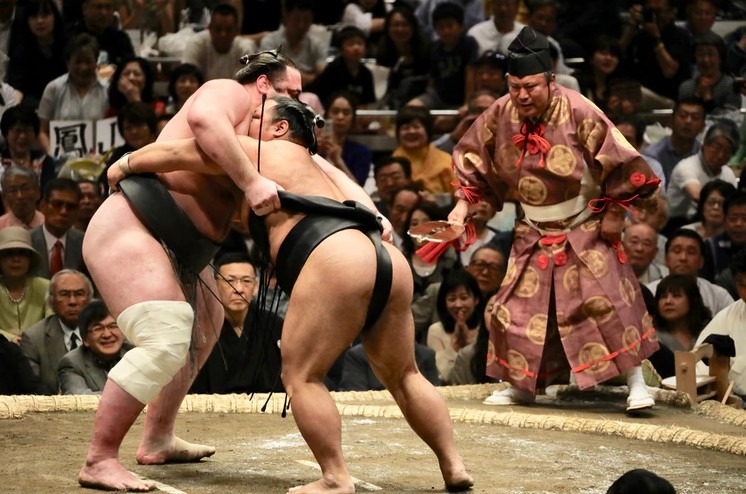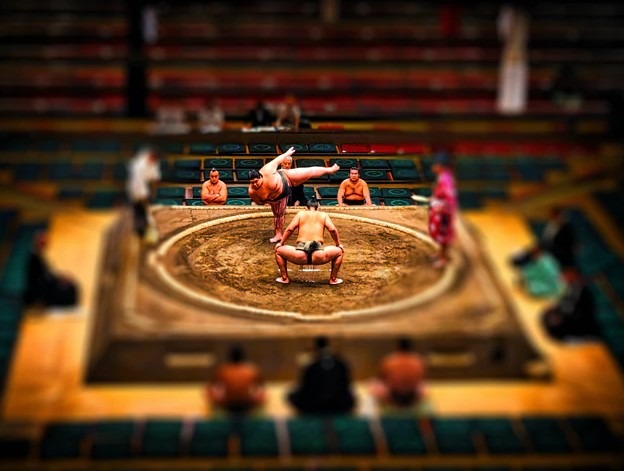Sumo wrestling is arguably one of the most popular sports in Japan, and it could even be considered the most popular due to its cultural impact in the country. The sports involve two wrestlers (called rikishi) trying to force each other out of the circular ring (called dohyō) or to force the opponent’s body parts, except the soles of the feet, to touch the ground. Now, it may seem like a simple sport to play, but sumo requires strategy, power, and durability in order for a wrestler to win a game. To know more about this popular Japanese sport, here is a guide to sumo wrestling that includes its origin and rules.
Origins of Sumo
In several wall paintings that were believed to have been created before 1185, sumo wrestling was already predicted, although it was regarded as a ritual dance rather than a sport during those times. The first possible mention of sumo wrestling is in a Kojiki (a chronicle of myths and legends in Japan) manuscript that is believed to have been written in 712. According to the Kojiki, the owner of the islands of Japan was decided by a wrestling match between two gods, Takeminakata and Takemikazuchi. The latter won the match and the right to rule the land of Japan.
The first sumo match between humans was recorded in the Nihon Shoki (The Chronicles of Japan) in 720, and the match involves a man named Nomi no Sukune going against Taima no Kuehaya under the request of Emperor Suinin. After winning the match, Nomi no Sukune became known as the mythological ancestor of sumo.
During the middle ages in Japan, sumo wrestlers often fought to the death, with fighters using fists to knock out their opponents. However, it slowly became a regulated sport during the Heian period, where sumo’s ceremonial and religious importance was returned to it.
In the early years of the Edo period, sumo wrestling has been banned in the country, as many of the elite considered the sport a “nuisance” because it just instigates violence amongst civilians. But in 1684, the ban for the sport has been lifted, but it should only be held during charity events at Shinto shrines. Because sumo was considered a special event in that period, many administration organizers were able to attract thousands of audience members, and the sport eventually became popular around the country.
How Sumo is Played
In order to win a match of sumo, one wrestler must be able to topple, push, or pull his opponents to the ground, or he can force his opponent to step outside the ring. To make the match less violent and more organized, sumo wrestling organizers would impose kinjite or illegal techniques that shouldn’t be used in the match. These illegal techniques are:
- Grabbing or pulling a wrestler’s hair
- Punching or striking an opponent with an open fist
- Applying force towards the solar plexus
- Poking the eyes
There are also other ways for wrestlers to win a match, such as the opponent having an undone mawashi, which is the belt or clothing that serves as the most iconic image of the sport, or if the opponents did not show up for the match, even if he does have a good reason for not fighting, like having an injury.
At the start of the match, the two wrestlers would perform a deep squat that allows them to get a better sense of balance in the ring. After the squat, the wrestlers would then charge at each other, and their hands would typically be holding their opponent’s mawashi.
One bout of a match would usually last for only a few seconds due to the fast-paced tugging and pushing between the two wrestlers. But sometimes, a bout would last for minutes because of the wrestlers’ ability to resist their opponent’s pushes or tugs.
Almost all sumo wrestlers have a thick or wide body mass, and it is believed that their girth would help them have great strength while having better balance and resistance. In addition, unlike boxing, there are no weight classes in sumo, so a shorter or lighter wrestler can have a match with someone that is taller or heavier than him. Although there have been many heavy wrestlers that have won championship belts over the years, smaller wrestlers were proven to also be effective in the modern era because they have better control of their bodies to execute techniques. Despite the winning record of smaller wrestlers, the average weight of the best sumo wrestlers has increased. In 1969, the average weight for top division wrestlers was 125 kilograms, but in 2019, the average became 166 kilograms.
To decide the winner of the match, the gyōji or referee can sometimes call for the winner, but in most cases, the winner is decided by the shimpan or judges that are sitting outside the ring at eye level. The announcer of the winner will be the chief judge, who will first organize a mono-ii or conference among the judges before deciding on who should win the match. After the decision, the chief judge would usually go to the center of the ring and announce the winner. Occasionally, there are matches or bouts where the referee and the judges will have different decisions, but the judges will have a weightier decision on the winner.
Once the winner is announced, the referee will determine or show the kimarite or winning technique used by the wrestler to win the bout or match. There are 82 different winning techniques that are recognized by the Japan Sumo Association as of 2019, but there are also non-techniques or hiwaza that are considered winning moves. The hiwaza includes an accidental back step by the opponents that made him step out of the ring or the accidental fall of an opponent inside the ring.
If both wrestlers touched the ground at almost the same time, the wrestler whose body part touched the ground first would be declared the winner. The wrestler that touched the ground second will not win the match and will be considered a shini-tai or dead body in the ring.
Despite being considered a professional sport only in Japan, the impact and influence of sumo wrestling have reached several countries around the world. Today, there are sumo wrestlers that belong in other ethnicities, with the most popular being the Mongolian wrestler Ichinojō Takashi, whose birth name is Altankhuyag Ichinnorov.


